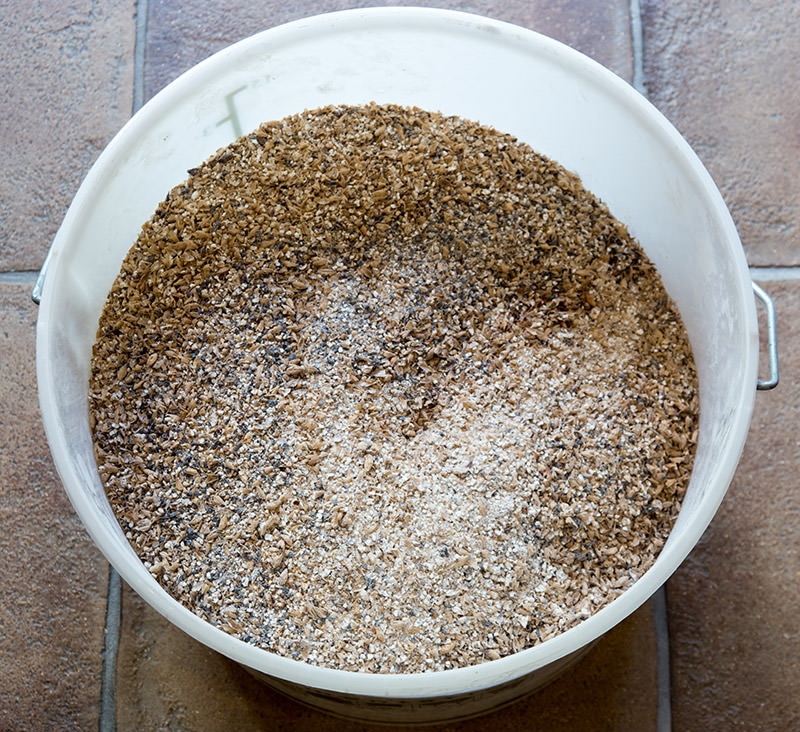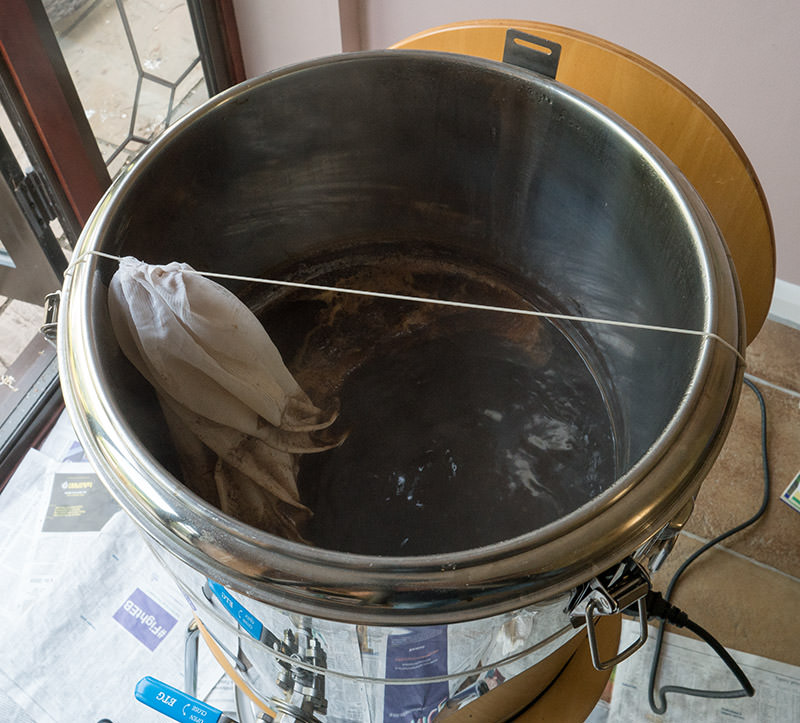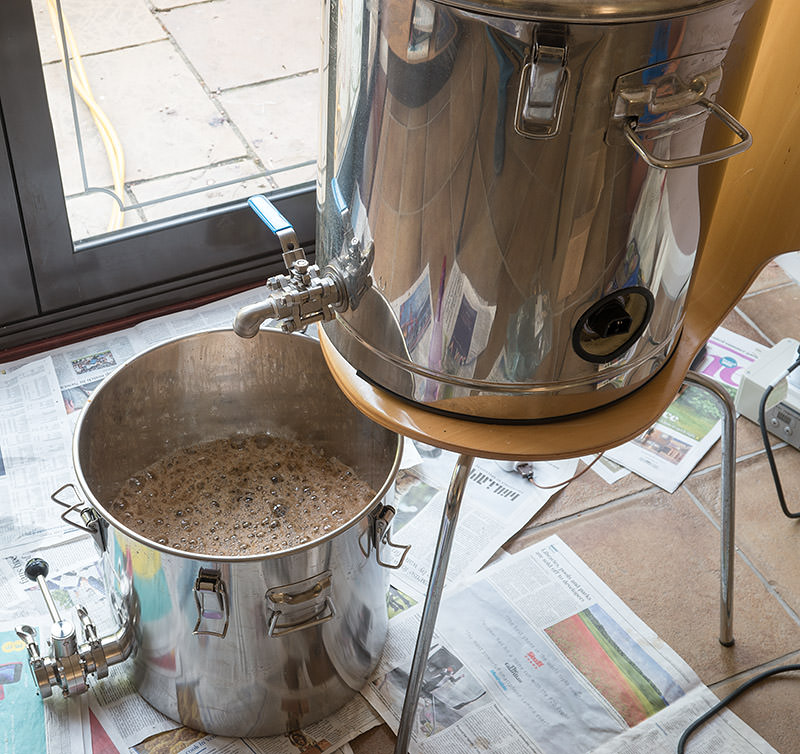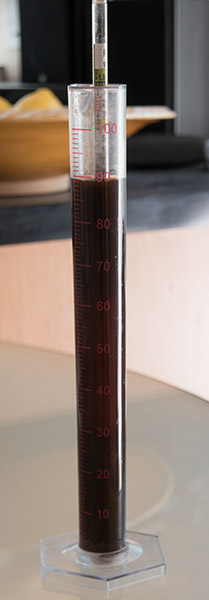Got up early doors this morning to get a 12 litre BIAB batch of Imperial Stout on the go. Hoping to be done and dusted before the England game at 1pm. The idea's to get this one bottled and aged for Christmas. This was my first big dark beer so I'm totally out of my comfort zone (a good thing) and had to do a fair bit of planning to get things where they needed to be.
Here's the abbreviated recipe for a guesstimate of 70% efficiency, that's 10% reduced from what I normally get since everyone says to lower your expectations for these types of beers.
Est. OG: 1.090
Est. IBU: 84
64% Pale malt
20% Munich malt
7% Roast barley
4% Crystal 240 EBC
3% Low colour chocolate malt
2% Special B 380 EBC
11g Polaris 18% AA 60 mins
11g Polaris 18% AA 30 mins
11g Polaris 18% AA 15 mins
Crushed the grains with the grinder set to 32 mils:

Mashed at 66C for 90 minutes giving it a quick stir at 45 mins because it was quite thick. Dunk sparged the bag for 10 minutes with 6 litres.
Pre-boil gravity was 1.070 for an 82% mash efficiency, easily beating the estimate of 1.065. Well pleased with my mash efficiency on this one.
Got the boil on nice and quick with this smaller batch.

Boiled for 90 minutes. Normally I do 60 minutes but in order to get enough water available for the sparge I had to boil for longer.
Oddly enough I got a lower boil-off rate of 2.8 litres/hour instead of my rate of 3.5 litres/hour despite the boil looking just as vigorous as usual. This meant the wort wasn't reduced as far as expected and I ended up with an OG of 1.088 - saved by my better than expected mash efficiency. Is lower boil-off expected for big beers? I don't know. Anyway 1.088 is fine by me and should result in a 9.0% beer.

Transferred 13 litres to the fermenter and pitched a 1.5 litre decanted starter of Wyeast 1728 at 18C. No action yet from the blow-off tube but I'm not concerned. It'll probably have kicked off by the morning.

Overall BH efficiency was 77%, only 5% down from the usual. Now if I can just figure out why I got a lower boil-off I'd be sorted for the next time.
Looking forward to trying this one at Christmas if I can keep my hands off it for that long.
Here's the abbreviated recipe for a guesstimate of 70% efficiency, that's 10% reduced from what I normally get since everyone says to lower your expectations for these types of beers.
Est. OG: 1.090
Est. IBU: 84
64% Pale malt
20% Munich malt
7% Roast barley
4% Crystal 240 EBC
3% Low colour chocolate malt
2% Special B 380 EBC
11g Polaris 18% AA 60 mins
11g Polaris 18% AA 30 mins
11g Polaris 18% AA 15 mins
Crushed the grains with the grinder set to 32 mils:

Mashed at 66C for 90 minutes giving it a quick stir at 45 mins because it was quite thick. Dunk sparged the bag for 10 minutes with 6 litres.
Pre-boil gravity was 1.070 for an 82% mash efficiency, easily beating the estimate of 1.065. Well pleased with my mash efficiency on this one.
Got the boil on nice and quick with this smaller batch.

Boiled for 90 minutes. Normally I do 60 minutes but in order to get enough water available for the sparge I had to boil for longer.
Oddly enough I got a lower boil-off rate of 2.8 litres/hour instead of my rate of 3.5 litres/hour despite the boil looking just as vigorous as usual. This meant the wort wasn't reduced as far as expected and I ended up with an OG of 1.088 - saved by my better than expected mash efficiency. Is lower boil-off expected for big beers? I don't know. Anyway 1.088 is fine by me and should result in a 9.0% beer.

Transferred 13 litres to the fermenter and pitched a 1.5 litre decanted starter of Wyeast 1728 at 18C. No action yet from the blow-off tube but I'm not concerned. It'll probably have kicked off by the morning.

Overall BH efficiency was 77%, only 5% down from the usual. Now if I can just figure out why I got a lower boil-off I'd be sorted for the next time.
Looking forward to trying this one at Christmas if I can keep my hands off it for that long.


















![BREWING THERMOMETER STICKERS ACCURATELY MONITOR FERMENTING BEER & WINE LIQUID TEMPERATURES 5PCS HOME BREW SPIRITS WINE LCD ADHESIVE [US]](https://m.media-amazon.com/images/I/311DDjo2X3L._SL500_.jpg)






















